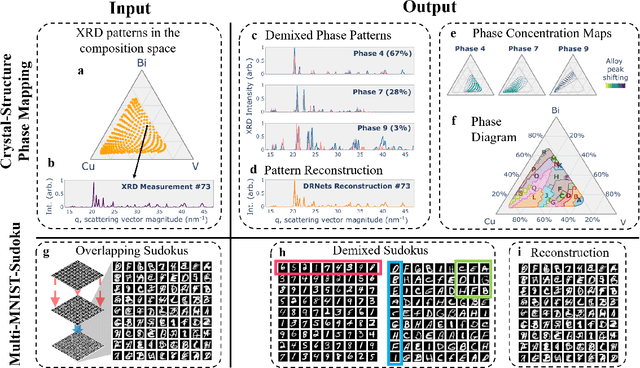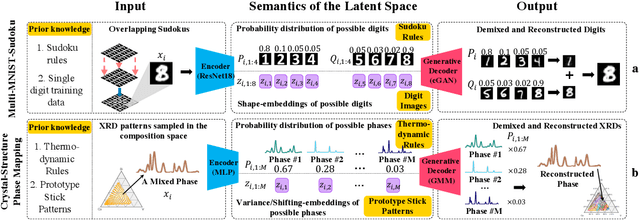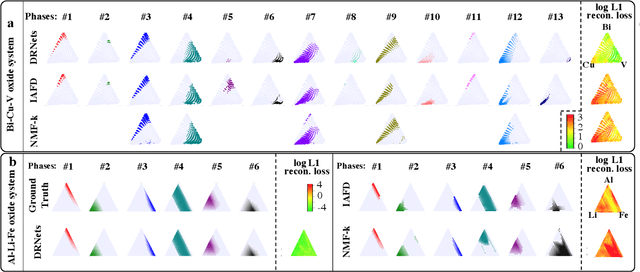R. Bruce van Dover
Probabilistic Phase Labeling and Lattice Refinement for Autonomous Material Research
Aug 15, 2023Abstract:X-ray diffraction (XRD) is an essential technique to determine a material's crystal structure in high-throughput experimentation, and has recently been incorporated in artificially intelligent agents in autonomous scientific discovery processes. However, rapid, automated and reliable analysis method of XRD data matching the incoming data rate remains a major challenge. To address these issues, we present CrystalShift, an efficient algorithm for probabilistic XRD phase labeling that employs symmetry-constrained pseudo-refinement optimization, best-first tree search, and Bayesian model comparison to estimate probabilities for phase combinations without requiring phase space information or training. We demonstrate that CrystalShift provides robust probability estimates, outperforming existing methods on synthetic and experimental datasets, and can be readily integrated into high-throughput experimental workflows. In addition to efficient phase-mapping, CrystalShift offers quantitative insights into materials' structural parameters, which facilitate both expert evaluation and AI-based modeling of the phase space, ultimately accelerating materials identification and discovery.
Automating Crystal-Structure Phase Mapping: Combining Deep Learning with Constraint Reasoning
Aug 21, 2021



Abstract:Crystal-structure phase mapping is a core, long-standing challenge in materials science that requires identifying crystal structures, or mixtures thereof, in synthesized materials. Materials science experts excel at solving simple systems but cannot solve complex systems, creating a major bottleneck in high-throughput materials discovery. Herein we show how to automate crystal-structure phase mapping. We formulate phase mapping as an unsupervised pattern demixing problem and describe how to solve it using Deep Reasoning Networks (DRNets). DRNets combine deep learning with constraint reasoning for incorporating scientific prior knowledge and consequently require only a modest amount of (unlabeled) data. DRNets compensate for the limited data by exploiting and magnifying the rich prior knowledge about the thermodynamic rules governing the mixtures of crystals with constraint reasoning seamlessly integrated into neural network optimization. DRNets are designed with an interpretable latent space for encoding prior-knowledge domain constraints and seamlessly integrate constraint reasoning into neural network optimization. DRNets surpass previous approaches on crystal-structure phase mapping, unraveling the Bi-Cu-V oxide phase diagram, and aiding the discovery of solar-fuels materials.
Autonomous synthesis of metastable materials
Jan 19, 2021



Abstract:Autonomous experimentation enabled by artificial intelligence (AI) offers a new paradigm for accelerating scientific discovery. Non-equilibrium materials synthesis is emblematic of complex, resource-intensive experimentation whose acceleration would be a watershed for materials discovery and development. The mapping of non-equilibrium synthesis phase diagrams has recently been accelerated via high throughput experimentation but still limits materials research because the parameter space is too vast to be exhaustively explored. We demonstrate accelerated synthesis and exploration of metastable materials through hierarchical autonomous experimentation governed by the Scientific Autonomous Reasoning Agent (SARA). SARA integrates robotic materials synthesis and characterization along with a hierarchy of AI methods that efficiently reveal the structure of processing phase diagrams. SARA designs lateral gradient laser spike annealing (lg-LSA) experiments for parallel materials synthesis and employs optical spectroscopy to rapidly identify phase transitions. Efficient exploration of the multi-dimensional parameter space is achieved with nested active learning (AL) cycles built upon advanced machine learning models that incorporate the underlying physics of the experiments as well as end-to-end uncertainty quantification. With this, and the coordination of AL at multiple scales, SARA embodies AI harnessing of complex scientific tasks. We demonstrate its performance by autonomously mapping synthesis phase boundaries for the Bi$_2$O$_3$ system, leading to orders-of-magnitude acceleration in establishment of a synthesis phase diagram that includes conditions for kinetically stabilizing $\delta$-Bi$_2$O$_3$ at room temperature, a critical development for electrochemical technologies such as solid oxide fuel cells.
 Add to Chrome
Add to Chrome Add to Firefox
Add to Firefox Add to Edge
Add to Edge